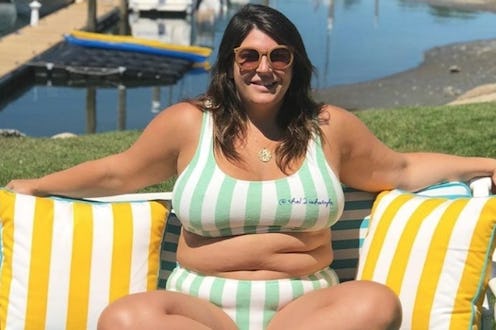Fashion
The #MakeMySize Movement On Instagram Urges Brands To Become More Size Inclusive
While there is more body diversity in fashion, on runways, and in campaigns, that doesn't mean that that representation translates to clothing options for plus size bodies in stores. Seeing curvy women on ads is different from walking into a shop and seeing a wide range of options in inclusive sizes, which is why Katie Sturino started the #MakeMySize movement on social media.
Sturino is the New York fashion blogger behind The 12ish Style, which is a style blog for "size 12ish-18ish girls living in a size 2 world."
She created the movement on Aug. 23, when Sturino took to Instagram Stories to vent her frustration on being an average size woman in the U.S. and constantly struggling to find items in her measurements. In a poll, she asked her followers if they were sick of trying on clothes that didn't fit, and 97 percent responded yes. The hashtag #MakeMySize soon followed. This is similar to the #PlusSizePlease movement that started in 2015.
In an Instagram photo of Sturino trying to put on jeans in her size but having them stop at her thighs, she explained why she started the hashtag and why it was important.
"You guys, I can’t stop!!! I’ve hit my limit with designers who don’t consider my body type! Please post your frustrated fitting room selfies and the styles you wish were available to you with the #MakeMySize hashtag...they are listening...let them know," she captioned the photo. "(these are @frame jeans size 32/XL/14.)"
By encouraging her followers and readers to share their changing room frustrations and tagging the brands who don't consider their size or body shapes, Sturino hopes that the movement will make the designers feel accountable and pressure them to create a more size inclusive range.
Sturino went on to share a few more dressing room selfies, demonstrating how "bigger" sizes still exclude a large amount of women. For example, trying on an XL dress at Zara, the wrap frock was so small that she couldn't put her arms all the way down or button the front, leaving her entire bra exposed.
"@zara is at the top of the #MakeMySize list bc they have been making me feel bad in the fitting room for years. In fact, I stopped even trying about 6 years ago. Went in today, same deal. This is an XL and I can’t get my arms down let alone try to close the front," Sturino wrote in the caption.
She then went on to try an Alice + Olivia leopard print wrap dress, with the same outcome. "I love this leopard wrap dress and I’d love to wear it in my size. Let’s let designers know we want to wear their clothes too," she captioned.
Alice + Olivia responded to the tags, albeit in a disappointing way. The first comment read, "Your breasts are epic! Your waist is tiny! What about trying the skirt and top version of this look? It will fit and give you the same look!" Commenters thought this was a poor response, and urged the brand to increase its size range rather than suggesting limited options.
The brand responded, "I am getting a lot of comments about this—as a brand we take a lot of pride in designing for and making clothes for a variety of body types—but not every dress can be made to fit every body—that is what when there is a really popular print like this one we make an extreme effort to offer it in other styles too—it comes in a blouse and as a skirt which can be better options for women who are more voluptuous on top."
After an avalanche of responses back to Alice + Olivia from her followers, Sturino stepped in and explained why the brand was experiencing negative feedback. "Instead of being open to my/our request for more inclusive sizing, you are suggesting I try and squeeze my shape into a size that does not and has never fit me from your brand. Many brands are working to expand their range in some capacity. I’m just asking you to consider doing the same."
In the end, Sturino was right: With the #MakeMySize movement, brands are hearing what their customers are saying — whether they like it or not.
